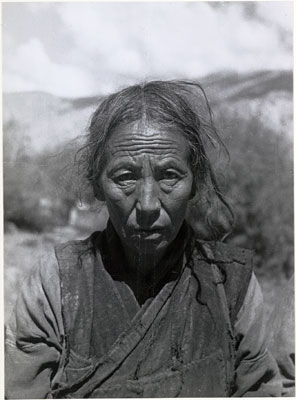
BMR.86.1.39.1 (Album Print black & white)


BMR.86.1.39.1 (Album Print black & white)

Frederick Spencer Chapman
Hugh E. Richardson
September 19th 1936
Lhasa > Ragyapa camp
BMR.86.1.39.1
Print gelatin silver
British Diplomatic Mission to Lhasa 1936-37
Donated to the British Museum in 1986 by Hugh E. Richardson
CQ.20 [view film roll]
F. S. Chapman Collection in the Pitt Rivers Museum
1998.131.233
Notes on print/mount - The caption 'A Ra-gya-pa (disposer of dead bodies)' has been written across the back of the print in pencil. The back of the print is covered with crop, proof and other reproduction marks. These include the instruction to 'Cut as indicated and reduce to 3" across'. There is also the inscription '8-3 5/16' written in red crayon in the top right hand corner of the back of the print. The reference 'C-Q-20' has been written. A piece of thin paper has been stuck to the top of the print at the back. This folds over the front of the image and has been used to transfer information from the back to the front. This paper also bears the caption 'A Ra-gyap-pa (Disposer of Dead Bodies', '2 5/8 x 7/[1]8)' and the letter 'N' written in red crayon [MS 4/2/2005]
Manual Catalogues - Caption in Chapman's hand-written list of negatives made whilst on the Mission to Lhasa, 1936-7 [See PRM Manuscripts Collection]: 'Close up of one [female body cutter]'; PRM Manuscripts Collection: ‘List of Tibetan Prints and Negatives’ - Book 4: ‘17/2 - A Ragyapa or outcast’ [MS 16/03/2006]
Other Information - Related Images: Images prefixed with 'CQ.' comprise a group of negatives containing images of beggars, Kundeling monastery, Potala, telephoto views of Potala, Tibetan dancers, Tibetan band, dancing girls, Tibetan telegraph master, female 'body cutters', old city magistrate and an Austin car. They all seem to have been taken between September 17th - 19th 1936 [MS 16/03/2006]
Other Information - Description: Chapman described encountering the dwellings of Ragyapa people in his book Lhasa the Holy City [London: Chatto & Windus 1938; reprint, London: Readers Union Ltd., 1940, pp.166-7]. He describes encountering a group when completing a circuit of the Linghkor pilgrimage route around Lhasa close to the Regent's summer palace: "On the left of the road are the hovels of the lowest class of Lhasa society, the ra-gyap-pa, a community of scavenging beggars whose work is to dispose of the dead bodies. ... These ra-gyap-pa must also remove the carcasses of animals that die in the city. Another of their duties is to seek out thieves and robbers who flee from the city to the surrounding country. At the time of the 1904 [Younghusband] Mission they were put in charge of convicts, but the practice has been discontinued. Soon after our arrival a dozen of these ra-gyap-pa came round to the Norbhu Lingka to ask for money, or rather to demand it as their right. For all officials visiting Lhasa must pay them on arrival and departure; similarly when an official is promoted, and on days of festival, these importunate fellows appear. If they are not paid they break into such a frenzied yelling and cursing that it is better to settle up at once and let them go. Some of the ra-gyap-pa are very wealthy and wear the saucer-shaped hat and ear-ring of respectability. ... Beside the track an aged wizened woman with white hair raises herself from her patchwork sheepskin bag, in which she lies to keep warm, and in a thin whining voice asks for alms" [1938, ibid., p.166] [MS 21/3/2005]
Other Information - Historical Background: The British Mission to Lhasa of 1936 included Captain W. S. Morgan of the Indian Medical Service, who undertook some medical activities, including the removal of cataracts. See 1998.131.287, 1998.131.644 and 1998.131.648 [MS 4/2/2005]
For Citation use:
The Tibet Album.
"Ragyapa woman"
05 Dec. 2006. The British Museum.
<http://tibet.prm.ox.ac.uk/photo_BMR.86.1.39.1.html>.
For more information about photographic usage or to order prints, please visit the The British Museum.
© The British Museum